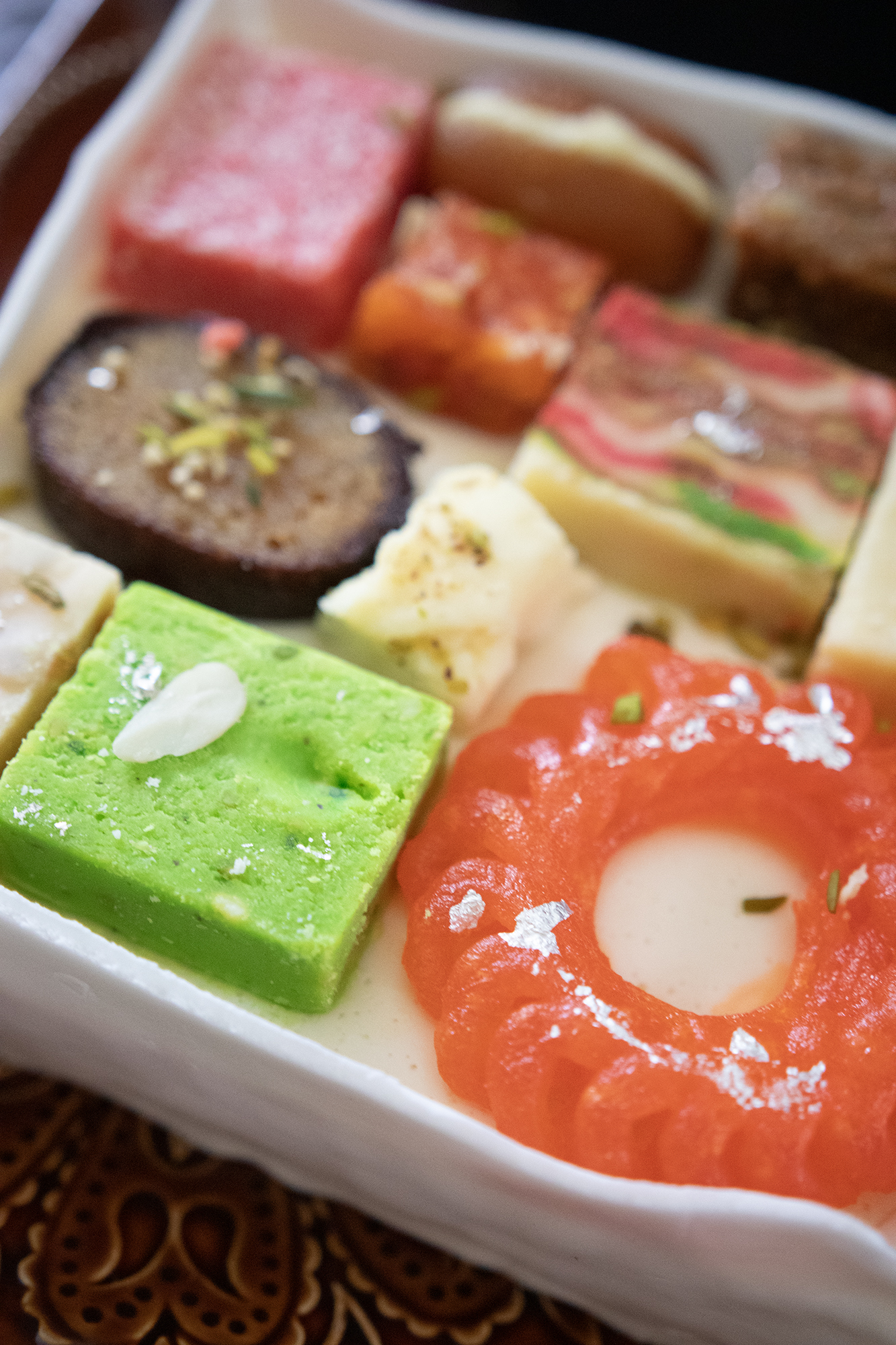
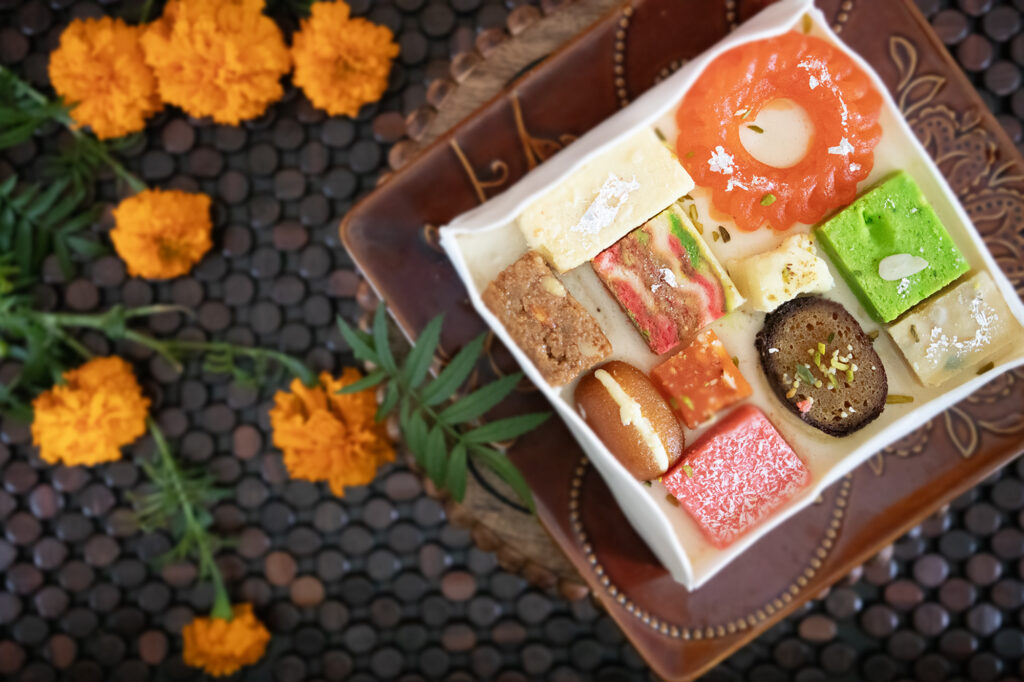
Life is life a box of Chocolates, only better if it’s a box of Mithai. Mithai refers to traditional Indian sweets and desserts, which are often made from ingredients like milk, sugar, and flour, and sometimes flavored with cardamom, saffron, nuts, and dried fruits. These sweets are integral to Indian festivals, celebrations, and rituals. There are many popular types of mithai, such as:
- Gulab Jamun – Fried dough balls soaked in sugar syrup.
- Rasgulla – Soft, spongy balls made from chhena (Indian cottage cheese) soaked in sugar syrup.
- Barfi – A dense, milk-based sweet, often flavored with cardamom or nuts.
- Ladoo – Round sweets made from flour, sugar, and ghee.
- Jalebi – Spiral-shaped, deep-fried batter soaked in sugary syrup.
- Kaju Katli – A diamond-shaped sweet made with cashew nuts.
- Peda – A small, round sweet made from khoya (dried milk) and sugar.
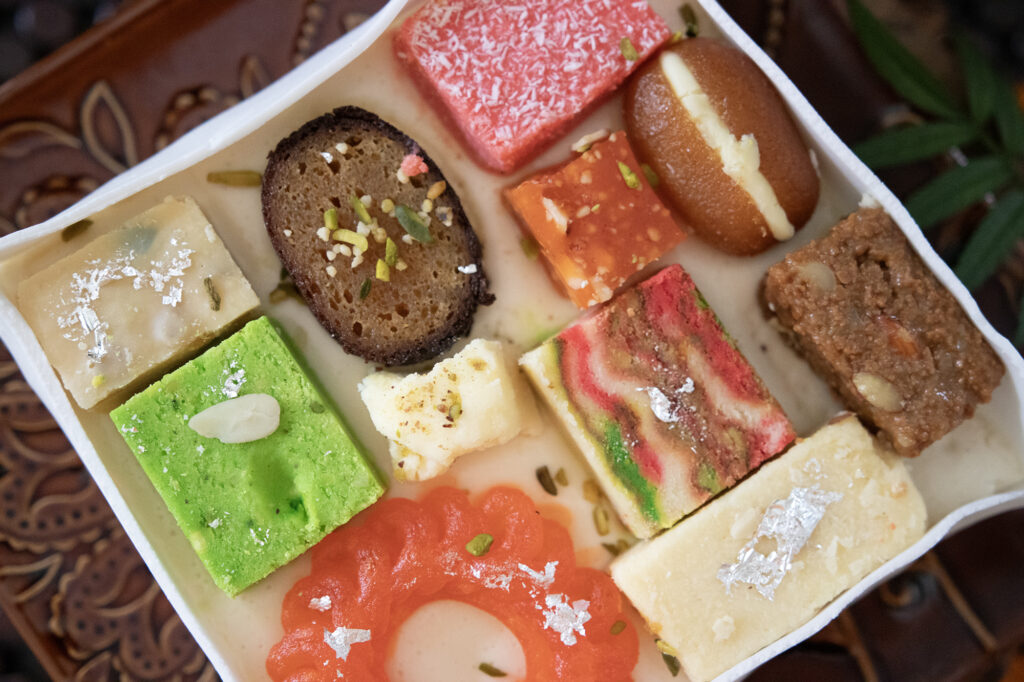
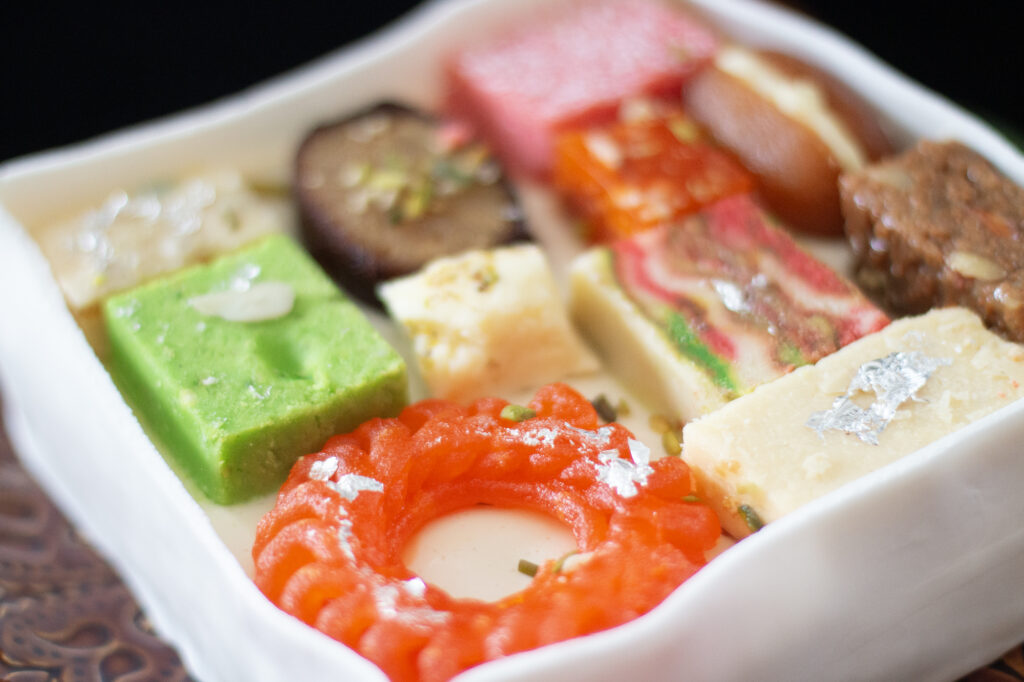
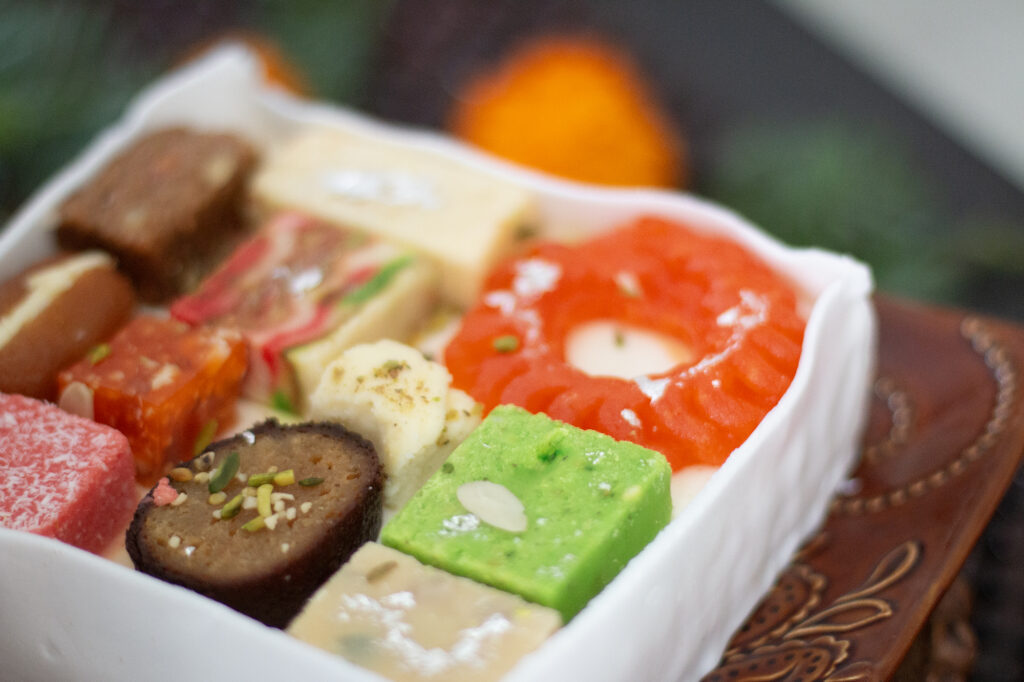
Mithai is a part of Indian culture, shared during festivals like Diwali, Holi, and Eid, and it is also exchanged as gifts during weddings and other important ceremonies. Till today, I’m excited to crack open a box of this to reveal all the colours and shapes. And yes, I’ve turned it into a Cheesecake!
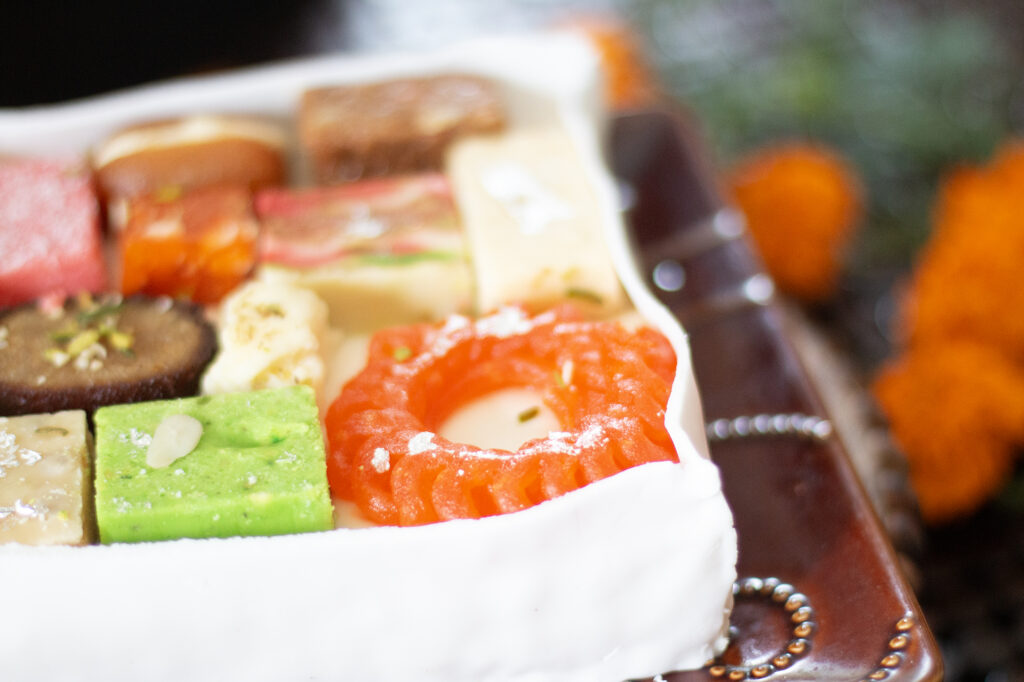
When it comes to these delicious delights, there are many to choose from – The Indian subcontinent boasts an incredible variety of mithai, with hundreds of distinct types reflecting the region’s diverse cultures, ingredients, and culinary traditions. While it’s difficult to provide an exact number due to regional variations and new creations, traditional mithai can be broadly categorized based on their ingredients and preparation methods.
Here’s an overview of the most common categories of mithai:
1. Milk-based Mithai
- Rasgulla (spongy, syrupy cheese balls)
- Sandesh (Bengali sweet made from chhena)
- Barfi (dense, milk-based sweet, sometimes with nuts or flavors)
- Peda (khoya-based sweet, often shaped into discs)
- Kalakand (moist, grainy-textured sweet from milk)
- Rabri (thickened, sweetened milk often served with nuts)
2. Flour-based Mithai
- Besan Ladoo (sweet balls made from roasted gram flour)
- Jalebi (spiral-shaped, sugar syrup-soaked fried sweet)
- Imarti (similar to jalebi but made from urad dal)
- Balushahi (a dense, flaky flour sweet soaked in syrup)
3. Lentil-based Mithai
- Mysore Pak (a rich, gram flour-based sweet with ghee)
- Mohanthal (dense sweet made from besan and sugar syrup)
4. Nut-based Mithai
- Kaju Katli (cashew nut fudge, thin and diamond-shaped)
- Badam Halwa (smooth, rich almond sweet)
- Kaju Roll (cashew-based rolled sweet sometimes stuffed)
5. Syrup-based Mithai
- Gulab Jamun (fried dough balls soaked in rose-flavored syrup)
- Malpua (sweet, fried pancakes often soaked in syrup)
- Chhena Poda (baked chhena soaked in sugar syrup)
6. Rice-based Mithai
- Pitha (varieties of sweet rice cakes from Eastern India)
- Payasam or Kheer (a rice pudding flavored with cardamom and nuts)
7. Semolina-based Mithai
- Sooji Halwa (semolina pudding made with ghee and sugar)
- Rava Ladoo (ladoo made from semolina)
8. Miscellaneous
- Puran Poli (a sweet stuffed flatbread made with lentil and jaggery filling)
- Modak (steamed dumpling with sweet coconut-jaggery filling, especially for Ganesh Chaturthi)
- Pathishapta (Bengali sweet crepe filled with coconut and jaggery)
Regional Variations:
- North India: Ghevar, Petha, Pinni
- West India: Shrikhand, Basundi, Mohanthal
- East India: Rasgulla, Sandesh, Chhena Poda, Patishapta
- South India: Mysore Pak, Adhirasam, Kozhukattai
Given the vastness of Indian cuisine, each region offers its own unique and sometimes lesser-known varieties. Festivals, traditions, and even seasons influence the preparation of different mithai.
It’s safe to say there are hundreds of types of mithai across India, and the number keeps growing with modern innovations and fusion desserts!
For this dessert, I’ve chosen a variety of shapes, flavours and colors but I’ve made sure they are all soft enough to cut through easily when you cut through the Cheesecake.
I’ve also chosen to make a no bake cheesecake as this is a creamy contrast to the sweet Mithai!
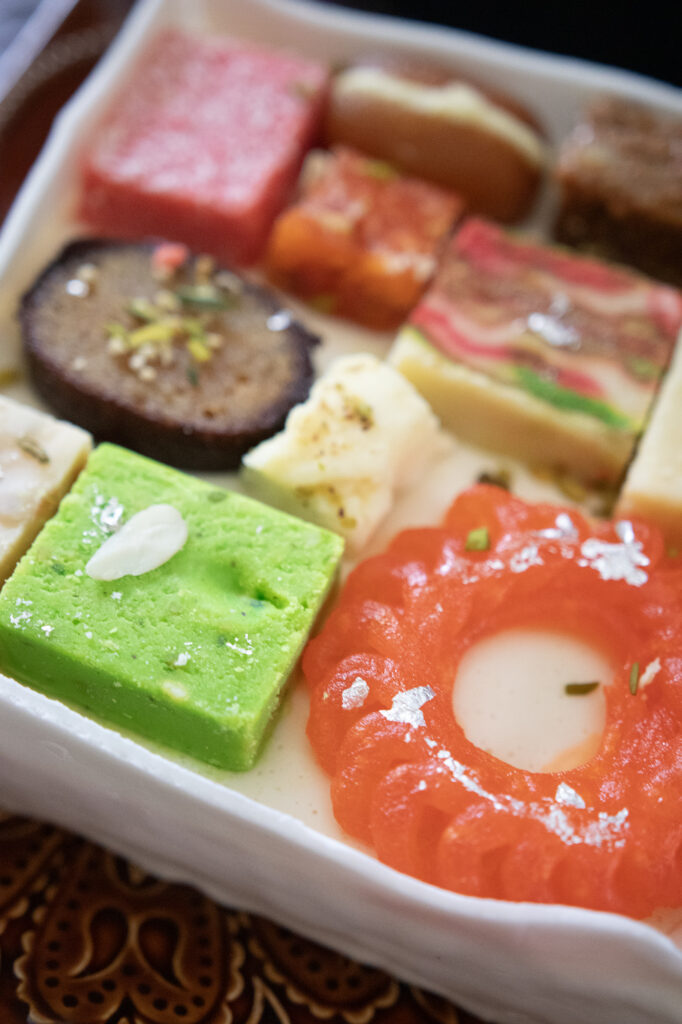
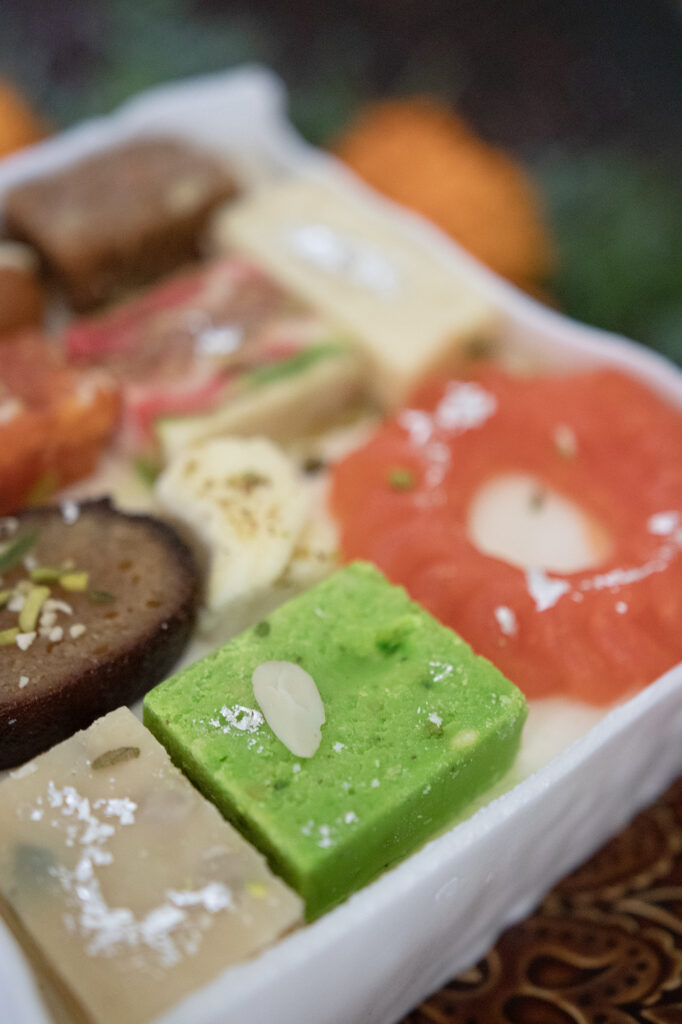
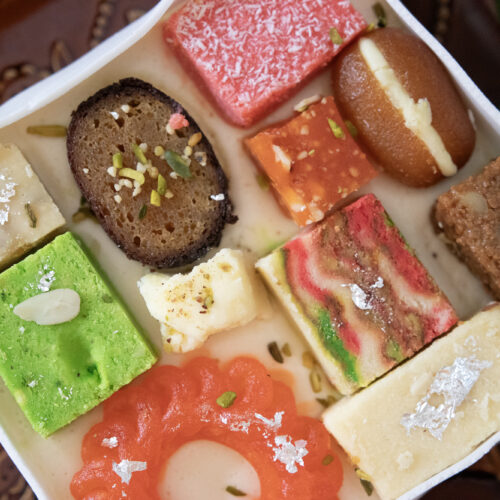
Mithai Cheesecake
Ingredients
Cheesecake base
- 200 gms/ 2 cups Marie Biscuits crushed
- 1/2 cup melted Butter
Cheesecake
- 500 gms Cream Cheese
- Juice of 1/2 Lemon
- 1 tsp Vanilla essence
- 300 ml Condensed Milk
- 1.5 packages – 1.5 tbsps 22.5 ml Gelatine
- 100 – 150 ml hot Water
Topping
- Mithai to cover the Cheesecake according to your choice & preference
Instructions
- Crush the Marie biscuits or use pre crushed crumbs
- Drizzle the butter over the crumbs till they are moist. You can add a little more or less as needed
- Once moist pack in firmly into a prepared square pan with the back of a spoon
- I’ve used an 18 x 18 cm pan but you can use a similar size springform pan as well
- Because I don’t have a square springform pan, I have lined this on one side with a long piece of parchment so I can lift the cake up and I’ve added two strips on either side as well
- Set this aside in the fridge for about 30 mins so the base is nice and firm
- Warm the Cream cheese up in the microwave just so it’s easier to whip
- Add the juice of the Lemon
- Add the Vanilla essence & Condensed Milk and whisk this together
- Add the Gelatine in hot Water and stir to dissolve
- If there are clumps, press on it with the back of your spoon
- Allow this to cool down
- When it’s warm, not hot, add it to the cheesecake mixture and whisk to make sure it’s well incorporated
- Make sure to scrape down the sides and pour this over the cookie base
- Put this in the fridge for an hour or so so it’s semi set
- Use a template to decide how you will position your Mithai
- After the cheesecake is semi set, lay the Mithai on top
- Set this overnight in the fridge
- Once set, and this is totally optional, roll out and measured strips of white fondant to stick to each side. This gives it the real mithai box look, but it also looks pretty good without it!

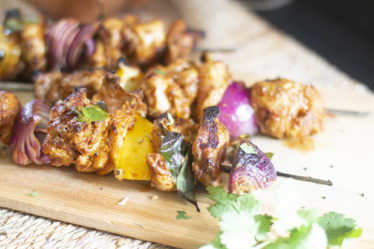

you are in reality a just right webmaster. The site loading speed is incredible. It kind of feels that you’re doing any unique trick. In addition, The contents are masterwork. you’ve done a fantastic task in this matter!
เว็บตรง เว็บพนันออนไลน์ สล็อต บาคาร่าเว็บตรง Asia999 เราคือ เว็บตรง
Hello.This post was extremely fascinating, particularly because I was browsing for thoughts on this issue last Wednesday.
I have learned newer and more effective things by means of your website. One other thing I would really like to say is the fact that newer computer system operating systems have a tendency to allow extra memory to be used, but they additionally demand more memory simply to function. If your computer can not handle more memory along with the newest computer software requires that memory space increase, it can be the time to buy a new Computer system. Thanks
Hey there! This post could not be written any better! Reading this post reminds me of my previous room mate! He always kept chatting about this. I will forward this write-up to him. Fairly certain he will have a good read. Thank you for sharing!
F*ckin? amazing things here. I am very glad to see your post. Thanks a lot and i am looking forward to contact you. Will you kindly drop me a e-mail?
We’re a group of volunteers and starting a new scheme in our community. Your web site offered us with valuable information to work on. You’ve done an impressive job and our whole community will be thankful to you.
I’m typically to running a blog and i actually respect your content. The article has actually peaks my interest. I’m going to bookmark your website and maintain checking for brand new information.
Thanks, I have recently been looking for information approximately this subject for a long time and yours is the best I have found out so far. But, what concerning the bottom line? Are you positive about the supply?
Thank you for the auspicious writeup. It in fact was a amusement account it. Look advanced to far added agreeable from you! However, how can we communicate?
Hmm is anyone else experiencing problems with the pictures on this blog loading? I’m trying to find out if its a problem on my end or if it’s the blog. Any feed-back would be greatly appreciated.
I’m extremely impressed with your writing skills as well as with the layout on your blog. Is this a paid theme or did you customize it yourself? Either way keep up the excellent quality writing, it is rare to see a great blog like this one nowadays..
I love your blog.. very nice colors & theme. Did you create this website yourself or did you hire someone to do it for you? Plz reply as I’m looking to design my own blog and would like to know where u got this from. cheers
Thanks for your submission. Another factor is that being a photographer involves not only trouble in taking award-winning photographs but additionally hardships in acquiring the best photographic camera suited to your needs and most especially hardships in maintaining the grade of your camera. This is certainly very correct and evident for those photography lovers that are in capturing the nature’s eye-catching scenes : the mountains, the forests, the wild or perhaps the seas. Going to these exciting places unquestionably requires a camera that can meet the wild’s hard settings.
Superb blog! Do you have any helpful hints for aspiring writers? I’m hoping to start my own website soon but I’m a little lost on everything. Would you suggest starting with a free platform like WordPress or go for a paid option? There are so many choices out there that I’m completely overwhelmed .. Any ideas? Thank you!
Thank you for the auspicious writeup. It in truth was once a entertainment account it. Glance complex to far added agreeable from you! However, how can we communicate?
Wow, wonderful weblog layout! How long have you been running a blog for? you made blogging glance easy. The whole look of your site is magnificent, as well as the content!
Nice post. I was checking constantly this blog and I’m impressed! Extremely useful information specifically the last part 🙂 I care for such info a lot. I was seeking this certain info for a very long time. Thank you and good luck.
Wonderful items from you, man. I’ve bear in mind your stuff previous to and you are just extremely excellent. I really like what you have acquired right here, certainly like what you are stating and the way in which in which you say it. You make it enjoyable and you still take care of to stay it smart. I can’t wait to read far more from you. That is actually a wonderful site.
There may be noticeably a bundle to find out about this. I assume you made sure nice factors in options also.
As a Newbie, I am continuously browsing online for articles that can aid me. Thank you
I will right away grab your rss as I can’t find your e-mail subscription link or e-newsletter service. Do you have any? Kindly let me know so that I could subscribe. Thanks.
you’re really a good webmaster. The site loading speed is incredible. It seems that you’re doing any unique trick. In addition, The contents are masterwork. you’ve done a magnificent job on this topic!
Hey, I think your blog might be having browser compatibility issues. When I look at your website in Opera, it looks fine but when opening in Internet Explorer, it has some overlapping. I just wanted to give you a quick heads up! Other then that, wonderful blog!
We absolutely love your blog and find most of your post’s to be just what I’m looking for. Does one offer guest writers to write content to suit your needs? I wouldn’t mind writing a post or elaborating on some of the subjects you write related to here. Again, awesome site!
Yet another thing to mention is that an online business administration program is designed for students to be able to easily proceed to bachelor degree programs. The 90 credit college degree meets the lower bachelor education requirements when you earn your current associate of arts in BA online, you will get access to up to date technologies in this particular field. Several reasons why students want to get their associate degree in business is because they can be interested in this area and want to receive the general knowledge necessary prior to jumping right bachelor college diploma program. Thanks alot : ) for the tips you really provide within your blog.
Thanks for your handy post. As time passes, I have been able to understand that the actual symptoms of mesothelioma are caused by a build up associated fluid between the lining in the lung and the chest cavity. The disease may start while in the chest area and multiply to other limbs. Other symptoms of pleural mesothelioma cancer include weight reduction, severe inhaling and exhaling trouble, a fever, difficulty ingesting, and bloating of the neck and face areas. It really should be noted that some people living with the disease do not experience any serious signs or symptoms at all.
Valuable information. Lucky me I found your website by accident, and I’m shocked why this accident didn’t happened earlier! I bookmarked it.
A large percentage of of the things you articulate happens to be supprisingly appropriate and that makes me ponder why I had not looked at this in this light previously. Your piece truly did switch the light on for me as far as this particular subject matter goes. However there is one factor I am not necessarily too comfy with and whilst I attempt to reconcile that with the actual core idea of your point, permit me see what all the rest of your visitors have to point out.Very well done.
Hello, Neat post. There’s a problem along with your site in web explorer, could test this? IE nonetheless is the marketplace leader and a large portion of people will leave out your magnificent writing due to this problem.
It?s really a nice and useful piece of info. I?m glad that you shared this useful info with us. Please keep us up to date like this. Thanks for sharing.
HSBC’s home equity release is aimed at assisting homeowners unlock the wealth tied up in their property. Should you need to supplement your retirement income, HSBC provides a secure solution with continued residence guaranteed. Their qualified advisors can help you assess your options with clarity.
Uncertain whether a secured loan is right for you? Understand the benefits, such as lower interest rates and larger borrowing amounts.
Unlock the equity in your property with a reliable home equity loan — ideal for covering home improvements, major purchases, or debt consolidation.
If you’re a homeowner looking to get a loan, a secured loan could be a sensible option. Leverage better rates by using your home as security.
If you’re a homeowner looking to borrow money, a secured loan could be a wise option. Access better rates by using your home as security.
Release the equity in your property with a reliable home equity loan — suitable for covering home improvements, large expenses, or refinancing.
Release the value in your property with a reliable home equity loan — suitable for funding home improvements, major purchases, or refinancing.
I like this blog very much, Its a rattling nice place to read and obtain info .
Are you considering a secured loan to consolidate your financial obligations? Find out more and check what solutions may be available to you.
If you’re a property owner looking to get a loan, a secured loan could be a sensible option. Leverage better rates by using your home as security.
I have realized that over the course of constructing a relationship with real estate proprietors, you’ll be able to get them to understand that, in most real estate exchange, a payment is paid. Eventually, FSBO sellers do not “save” the percentage. Rather, they struggle to earn the commission by way of doing a strong agent’s job. In this, they commit their money and time to conduct, as best they could, the tasks of an representative. Those responsibilities include uncovering the home by means of marketing, presenting the home to buyers, creating a sense of buyer desperation in order to trigger an offer, making arrangement for home inspections, managing qualification inspections with the mortgage lender, supervising repairs, and facilitating the closing of the deal.
Uncertain whether a secured loan is right for you? Understand the benefits, such as more favourable terms and larger borrowing amounts.
Considering releasing equity from your home? Review top lenders and understand your rights and obligations before making a decision.
Discover how a homeowner loan can help you obtain the money you need without parting with your home. Compare lenders and customise a plan that fits your needs.
Are you considering a loan against your home to manage your debts? Explore your choices and check what options may be available to you.
If you’re a homeowner looking to borrow money, a secured loan could be a wise option. Access better rates by using your home as security.
F*ckin? remarkable things here. I am very satisfied to look your post. Thanks so much and i am having a look forward to contact you. Will you please drop me a mail?
Thinking about a secured loan to consolidate your financial obligations? Explore your choices and see what solutions may be available to you.
Explore how a secured loan can help you access the money you need without selling your home. Compare lenders and tailor a plan that fits your needs.
Equity release solutions may provide the financial support you’ve been needing. Learn how to tap into the equity tied up in your home without having to downsize.
You may be able to borrow more and enjoy better interest rates by taking out a loan secured on your property. Find the best current offers today.
Wonderful blog! I found it while surfing around on Yahoo News. Do you have any suggestions on how to get listed in Yahoo News? I’ve been trying for a while but I never seem to get there! Cheers
Considering releasing equity from your home? Review top lenders and learn about your rights and obligations before making a decision.
Uncertain whether a secured loan is right for you? Understand the benefits, such as lower interest rates and increased flexibility.
whoah this blog is excellent i love reading your posts. Keep up the good work! You know, lots of people are searching around for this information, you can help them greatly.
Thinking about a secured loan to consolidate your financial obligations? Find out more and check what solutions may be available to you.
Release the value in your property with a reliable home equity loan — ideal for funding home improvements, major purchases, or refinancing.
You may be able to borrow more and enjoy lower monthly repayments by taking out a loan secured on your property. Review current offers today.
You may be able to borrow more and enjoy lower monthly repayments by using your home’s equity. Find the best current offers today.
Would you be fascinated about exchanging links?
Do you have a spam issue on this blog; I also am a blogger, and I was wanting to know your situation; many of us have developed some nice methods and we are looking to swap solutions with other folks, please shoot me an email if interested.
One more thing to say is that an online business administration diploma is designed for college students to be able to smoothly proceed to bachelors degree courses. The 90 credit education meets the other bachelor education requirements when you earn your associate of arts in BA online, you’ll have access to the modern technologies in such a field. Several reasons why students want to get their associate degree in business is because they’re interested in this area and want to have the general knowledge necessary prior to jumping right into a bachelor education program. Thanks alot : ) for the tips you really provide as part of your blog.
What i do not understood is actually how you are not actually much more well-liked than you may be right now. You’re very intelligent. You realize thus considerably relating to this subject, produced me personally consider it from so many varied angles. Its like men and women aren’t fascinated unless it?s one thing to accomplish with Lady gaga! Your own stuffs outstanding. Always maintain it up!
I’ve been absent for some time, but now I remember why I used to love this site. Thank you, I will try and check back more frequently. How frequently you update your website?
Attractive portion of content. I simply stumbled upon your website and in accession capital to claim that I get in fact enjoyed account your blog posts. Anyway I will be subscribing on your feeds and even I achievement you get entry to consistently fast.
When I initially commented I clicked the -Notify me when new comments are added- checkbox and now each time a remark is added I get four emails with the identical comment. Is there any way you can remove me from that service? Thanks!
Howdy! Someone in my Facebook group shared this site with us so I came to give it a look. I’m definitely loving the information. I’m bookmarking and will be tweeting this to my followers! Fantastic blog and wonderful design and style.
I think other website proprietors should take this website as an model, very clean and fantastic user friendly style and design, as well as the content. You are an expert in this topic!
When I originally commented I clicked the -Notify me when new feedback are added- checkbox and now each time a remark is added I get 4 emails with the same comment. Is there any way you may take away me from that service? Thanks!
One thing I’d prefer to reply to is that weight loss program fast may be possible by the perfect diet and exercise. Your size not merely affects appearance, but also the actual quality of life. Self-esteem, melancholy, health risks, plus physical capabilities are afflicted in weight gain. It is possible to just make everything right and still gain. In such a circumstance, a problem may be the reason. While an excessive amount food but not enough workout are usually accountable, common health conditions and trusted prescriptions can greatly amplify size. Thanks alot : ) for your post right here.
very good publish, i actually love this web site, carry on it
It?s actually a nice and helpful piece of information. I?m happy that you just shared this helpful information with us. Please stay us informed like this. Thanks for sharing.
I’m curious to find out what blog platform you are working with? I’m experiencing some small security issues with my latest website and I’d like to find something more risk-free. Do you have any recommendations?
Heya i?m for the first time here. I came across this board and I find It truly useful & it helped me out a lot. I hope to give something back and aid others like you helped me.
Youre so cool! I dont suppose Ive learn something like this before. So nice to find someone with some authentic thoughts on this subject. realy thanks for starting this up. this website is one thing that is wanted on the net, somebody with somewhat originality. useful job for bringing something new to the web!
The subsequent time I read a weblog, I hope that it doesnt disappoint me as much as this one. I imply, I know it was my option to learn, but I truly thought youd have something fascinating to say. All I hear is a bunch of whining about something that you can fix if you werent too busy in search of attention.
This article is a breath of fresh air! The author’s unique perspective and insightful analysis have made this a truly captivating read. I’m appreciative for the effort he has put into producing such an educational and mind-stimulating piece. Thank you, author, for providing your expertise and stimulating meaningful discussions through your brilliant writing!
Hi there! This post couldn’t be written any better! Reading through this post reminds me of my previous room mate! He always kept talking about this. I will forward this article to him. Pretty sure he will have a good read. Thank you for sharing!
Thanks for the concepts you talk about through this site. In addition, many young women who seem to become pregnant never even attempt to get health care insurance because they are full of fearfulness they won’t qualify. Although some states right now require that insurers provide coverage regardless of pre-existing conditions. Prices on these types of guaranteed options are usually greater, but when considering the high cost of health care it may be any safer strategy to use to protect the financial potential.
I do agree with all the ideas you’ve presented in your post. They are really convincing and will definitely work. Still, the posts are very short for newbies. Could you please extend them a bit from next time? Thanks for the post.
Hey There. I found your blog using msn. This is an extremely well written article. I will make sure to bookmark it and return to read more of your useful information. Thanks for the post. I?ll definitely return.
okmark your weblog and check again here frequently. I’m quite sure I?ll learn many new stuff right here! Best of luck for the next!
One other issue issue is that video games are generally serious naturally with the major focus on understanding rather than entertainment. Although, there is an entertainment aspect to keep your kids engaged, just about every game will likely be designed to work towards a specific set of skills or course, such as math or scientific research. Thanks for your post.
Yesterday, while I was at work, my sister stole my iPad and tested to see if it can survive a thirty foot drop, just so she can be a youtube sensation. My apple ipad is now destroyed and she has 83 views. I know this is completely off topic but I had to share it with someone!
wonderful issues altogether, you simply won a logo new reader. What would you recommend in regards to your submit that you just made a few days ago? Any certain?
whoah this blog is fantastic i love reading your articles. Keep up the good work! You know, many people are hunting around for this info, you can help them greatly.
Thanks for every other informative website. Where else may I get that kind of information written in such a perfect means? I have a project that I am just now operating on, and I’ve been on the glance out for such info.
Thanks a lot for the helpful write-up. It is also my belief that mesothelioma cancer has an very long latency period, which means that symptoms of the disease would possibly not emerge until eventually 30 to 50 years after the preliminary exposure to asbestos fiber. Pleural mesothelioma, which is the most common style and has effects on the area across the lungs, could potentially cause shortness of breath, upper body pains, and also a persistent coughing, which may lead to coughing up maintain.
I?ve recently started a blog, the info you offer on this web site has helped me greatly. Thank you for all of your time & work.
An impressive share, I simply given this onto a colleague who was doing a little bit evaluation on this. And he the truth is purchased me breakfast because I found it for him.. smile. So let me reword that: Thnx for the deal with! But yeah Thnkx for spending the time to debate this, I feel strongly about it and love reading extra on this topic. If potential, as you grow to be experience, would you mind updating your blog with extra particulars? It’s highly helpful for me. Huge thumb up for this weblog publish!
Very nice post. I just stumbled upon your weblog and wished to say that I have really enjoyed surfing around your blog posts. After all I?ll be subscribing to your feed and I hope you write again soon!
Hi, Neat post. There’s a problem with your website in internet explorer, would check this? IE still is the market leader and a huge portion of people will miss your excellent writing because of this problem.
One thing I’ve noticed is the fact there are plenty of beliefs regarding the lenders intentions while talking about foreclosures. One fable in particular is the fact the bank prefers to have your house. The financial institution wants your hard earned dollars, not the home. They want the funds they loaned you along with interest. Keeping away from the bank will only draw a new foreclosed conclusion. Thanks for your post.
Thanks for your posting on this weblog. From my very own experience, occasionally softening upward a photograph could possibly provide the digital photographer with a chunk of an imaginative flare. Sometimes however, the soft blur isn’t precisely what you had planned and can in many cases spoil a normally good photo, especially if you intend on enlarging this.
Thanks for the new things you have uncovered in your writing. One thing I’d prefer to comment on is that FSBO relationships are built eventually. By bringing out yourself to the owners the first saturday their FSBO can be announced, prior to a masses get started calling on Monday, you build a good link. By sending them resources, educational components, free reviews, and forms, you become a great ally. By subtracting a personal curiosity about them in addition to their situation, you generate a solid connection that, on most occasions, pays off once the owners opt with a real estate agent they know in addition to trust – preferably you.
I’m in awe of the author’s talent to make complex concepts understandable to readers of all backgrounds. This article is a testament to her expertise and commitment to providing helpful insights. Thank you, author, for creating such an engaging and illuminating piece. It has been an absolute pleasure to read!
Something more important is that when evaluating a good on the net electronics shop, look for online shops that are continually updated, always keeping up-to-date with the most recent products, the very best deals, plus helpful information on goods and services. This will make sure that you are doing business with a shop that stays atop the competition and provides you what you ought to make intelligent, well-informed electronics expenditures. Thanks for the significant tips I have really learned from your blog.
http://pinupaz.top/# pin up
safe online pharmacy: discreet shipping – secure checkout Viagra
modafinil legality: modafinil 2025 – legal Modafinil purchase
buy generic Cialis online: cheap Cialis online – cheap Cialis online
Modafinil for sale: modafinil 2025 – verified Modafinil vendors
order Cialis online no prescription: cheap Cialis online – order Cialis online no prescription
modafinil 2025: modafinil 2025 – Modafinil for sale
generic tadalafil [url=https://zipgenericmd.shop/#]order Cialis online no prescription[/url] reliable online pharmacy Cialis
doctor-reviewed advice: doctor-reviewed advice – buy modafinil online
doctor-reviewed advice: legal Modafinil purchase – doctor-reviewed advice
buy generic Cialis online: order Cialis online no prescription – generic tadalafil
order Viagra discreetly: discreet shipping – discreet shipping
https://maxviagramd.com/# secure checkout Viagra
discreet shipping [url=https://maxviagramd.com/#]buy generic Viagra online[/url] fast Viagra delivery
order Cialis online no prescription: online Cialis pharmacy – secure checkout ED drugs
best price for Viagra: trusted Viagra suppliers – fast Viagra delivery
cheap Cialis online: best price Cialis tablets – online Cialis pharmacy
reliable online pharmacy Cialis [url=https://zipgenericmd.shop/#]order Cialis online no prescription[/url] best price Cialis tablets
legit Viagra online: Viagra without prescription – buy generic Viagra online
modafinil 2025: doctor-reviewed advice – buy modafinil online
https://modafinilmd.store/# modafinil pharmacy
best price Cialis tablets [url=http://zipgenericmd.com/#]reliable online pharmacy Cialis[/url] best price Cialis tablets
same-day Viagra shipping: safe online pharmacy – buy generic Viagra online
https://zipgenericmd.shop/# Cialis without prescription
buy generic Viagra online: Viagra without prescription – Viagra without prescription
discreet shipping [url=http://maxviagramd.com/#]order Viagra discreetly[/url] no doctor visit required
I believe that avoiding highly processed foods is the first step to help lose weight. They can taste great, but packaged foods contain very little nutritional value, making you feed on more to have enough power to get throughout the day. If you are constantly taking in these foods, transferring to whole grains and other complex carbohydrates will assist you to have more power while feeding on less. Thanks alot : ) for your blog post.
safe modafinil purchase: Modafinil for sale – verified Modafinil vendors
buy generic Cialis online: reliable online pharmacy Cialis – generic tadalafil
http://maxviagramd.com/# discreet shipping
buy modafinil online: safe modafinil purchase – modafinil pharmacy
order Viagra discreetly: secure checkout Viagra – trusted Viagra suppliers
safe online pharmacy: trusted Viagra suppliers – order Viagra discreetly
best price for Viagra [url=https://maxviagramd.com/#]best price for Viagra[/url] no doctor visit required
reliable online pharmacy Cialis: online Cialis pharmacy – reliable online pharmacy Cialis
http://maxviagramd.com/# cheap Viagra online
same-day Viagra shipping: secure checkout Viagra – secure checkout Viagra
legit Viagra online: Viagra without prescription – secure checkout Viagra
I do agree with all the ideas you’ve presented in your post. They’re really convincing and will certainly work. Still, the posts are very short for newbies. Could you please extend them a little from next time? Thanks for the post.
secure checkout ED drugs [url=https://zipgenericmd.shop/#]Cialis without prescription[/url] generic tadalafil
https://maxviagramd.com/# same-day Viagra shipping
best price for Viagra: same-day Viagra shipping – secure checkout Viagra
One other thing is that an online business administration program is designed for people to be able to effortlessly proceed to bachelors degree courses. The 90 credit college degree meets the other bachelor education requirements when you earn the associate of arts in BA online, you’ll have access to the latest technologies with this field. Several reasons why students want to get their associate degree in business is because they may be interested in this area and want to find the general knowledge necessary just before jumping into a bachelor diploma program. Many thanks for the tips you provide in the blog.
modafinil pharmacy: modafinil 2025 – modafinil pharmacy
modafinil 2025 [url=http://modafinilmd.store/#]Modafinil for sale[/url] Modafinil for sale
https://modafinilmd.store/# safe modafinil purchase
buy generic Cialis online: affordable ED medication – best price Cialis tablets
secure checkout Viagra: order Viagra discreetly – same-day Viagra shipping
https://modafinilmd.store/# modafinil legality
order Cialis online no prescription [url=https://zipgenericmd.shop/#]discreet shipping ED pills[/url] Cialis without prescription
legit Viagra online: order Viagra discreetly – buy generic Viagra online
Amo Health Care: amoxicillin 500 mg online – can we buy amoxcillin 500mg on ebay without prescription
can you get cheap clomid online: can i purchase generic clomid – buying clomid without prescription
Thanks for your interesting article. Other thing is that mesothelioma is generally caused by the breathing of material from mesothelioma, which is a extremely dangerous material. It really is commonly witnessed among personnel in the structure industry who have long experience of asbestos. It is also caused by residing in asbestos covered buildings for years of time, Genetics plays a crucial role, and some people are more vulnerable on the risk compared to others.
PredniHealth [url=https://prednihealth.shop/#]prednisone for dogs[/url] PredniHealth
https://clomhealth.shop/# cheap clomid no prescription
can i get clomid without rx: Clom Health – get clomid now
no prescription online prednisone: prednisone 30 mg daily – purchase prednisone
can i order clomid pills: can you get cheap clomid – how can i get generic clomid without dr prescription
PredniHealth [url=https://prednihealth.com/#]20 mg prednisone[/url] PredniHealth
https://prednihealth.shop/# PredniHealth
generic clomid without rx: buying cheap clomid without insurance – where can i buy clomid for sale
generic clomid no prescription: Clom Health – get cheap clomid without a prescription
can i order clomid without prescription: buying generic clomid without insurance – can i get cheap clomid without rx
https://prednihealth.com/# PredniHealth
PredniHealth [url=https://prednihealth.shop/#]PredniHealth[/url] prednisone buy cheap
prednisone otc uk: PredniHealth – PredniHealth
amoxicillin medicine over the counter: amoxicillin 500mg capsules price – amoxicillin 775 mg
how to get cheap clomid without rx: how to get generic clomid – can you buy clomid for sale
https://amohealthcare.store/# Amo Health Care
order clomid without a prescription: can i buy clomid no prescription – cost of cheap clomid pills
Amo Health Care [url=https://amohealthcare.store/#]amoxicillin 500mg capsule buy online[/url] amoxicillin buy online canada
can i get clomid prices: Clom Health – cost of clomid for sale
how can i get clomid without rx: cost of clomid without dr prescription – cost cheap clomid without prescription
http://prednihealth.com/# can i buy prednisone online without prescription
order clomid tablets: Clom Health – how can i get cheap clomid without prescription
clomid sale: Clom Health – buy cheap clomid without dr prescription
Youre so cool! I dont suppose Ive learn anything like this before. So good to find somebody with some authentic thoughts on this subject. realy thanks for starting this up. this website is something that is wanted on the internet, someone with just a little originality. useful job for bringing one thing new to the web!
http://prednihealth.com/# PredniHealth
PredniHealth: buying prednisone on line – 20 mg prednisone tablet
can you get generic clomid without rx: Clom Health – where to buy generic clomid no prescription
1 mg prednisone daily [url=https://prednihealth.shop/#]can i buy prednisone online without prescription[/url] buy prednisone canadian pharmacy
https://clomhealth.com/# clomid price
buying prednisone from canada: PredniHealth – PredniHealth
prednisone 50: PredniHealth – online order prednisone
cheap clomid without rx [url=https://clomhealth.com/#]Clom Health[/url] can i order generic clomid without insurance
Hello, i believe that i noticed you visited my site thus i got here to ?go back the choose?.I am attempting to to find issues to improve my web site!I suppose its good enough to make use of a few of your ideas!!
https://prednihealth.com/# PredniHealth
https://tadalaccess.com/# cialis online usa
cialis for sale brand [url=https://tadalaccess.com/#]TadalAccess[/url] cialis dosage for ed
cheapest 10mg cialis: Tadal Access – cialis for bph insurance coverage
india pharmacy cialis: Tadal Access – buy cialis in toronto
https://tadalaccess.com/# cheap cialis
purchase cialis on line [url=https://tadalaccess.com/#]Tadal Access[/url] sildenafil and tadalafil
cialis 10 mg: generic cialis tadalafil 20mg reviews – cialis 20mg
buying cialis in canada: Tadal Access – can tadalafil cure erectile dysfunction
https://tadalaccess.com/# tadalafil softsules tuf 20
where can i buy tadalafil online: order cialis from canada – cialis coupon walgreens
evolution peptides tadalafil [url=https://tadalaccess.com/#]TadalAccess[/url] cialis from canada to usa
An interesting discussion is definitely worth comment. I do think that you should write more on this issue, it might not be a taboo subject but typically people don’t talk about these subjects. To the next! Cheers!
cialis advertisement: cialis 5mg price cvs – cialis using paypal in australia
https://tadalaccess.com/# cialis online without perscription
generic cialis from india: Tadal Access – evolution peptides tadalafil
I’m amazed, I must say. Seldom do I come across a blog that’s both equally educative and amusing, and without a doubt, you have hit the nail on the head. The problem is something that not enough men and women are speaking intelligently about. I’m very happy I came across this in my hunt for something relating to this.
tadalafil versus cialis [url=https://tadalaccess.com/#]purchasing cialis online[/url] sildenafil vs cialis
cialis 10mg price: Tadal Access – cialis once a day
https://tadalaccess.com/# does cialis really work
nebenwirkungen tadalafil: Tadal Access – what is cialis taken for
After study a few of the blog posts in your website now, and I truly like your manner of blogging. I bookmarked it to my bookmark website record and can be checking again soon. Pls try my site as effectively and let me know what you think.
what happens when you mix cialis with grapefruit? [url=https://tadalaccess.com/#]TadalAccess[/url] buy cialis online reddit
https://tadalaccess.com/# price of cialis at walmart
what are the side effect of cialis: buy tadalafil online paypal – cialis canada pharmacy no prescription required
tadalafil and ambrisentan newjm 2015: tadalafil no prescription forum – tadalafil liquid review
https://tadalaccess.com/# what is the normal dose of cialis
tadalafil (tadalis-ajanta) [url=https://tadalaccess.com/#]Tadal Access[/url] cialis tubs
cialis where can i buy: cialis available in walgreens over counter?? – cialis generic overnite
cheap generic cialis: natural cialis – cialis package insert
https://tadalaccess.com/# cialis softabs online
trusted online store to buy cialis: prescription free cialis – cialis dopoxetine
tadalafil generic in usa [url=https://tadalaccess.com/#]Tadal Access[/url] cialis dose
difference between cialis and tadalafil: TadalAccess – cialis 5 mg tablet
I have really learned some new things out of your blog post. Also a thing to I have observed is that in most cases, FSBO sellers will probably reject an individual. Remember, they will prefer to not use your solutions. But if you actually maintain a comfortable, professional relationship, offering aid and staying in contact for around four to five weeks, you will usually have the ability to win interviews. From there, a house listing follows. Cheers
https://tadalaccess.com/# cialis super active plus
where to buy cialis online: Tadal Access – cialis and alcohol
uses for cialis [url=https://tadalaccess.com/#]safest and most reliable pharmacy to buy cialis[/url] buy a kilo of tadalafil powder
difference between sildenafil and tadalafil: tadalafil vidalista – cialis 20 mg
https://tadalaccess.com/# cialis dapoxetine overnight shipment
cialis and cocaine: Tadal Access – oryginal cialis
can i take two 5mg cialis at once [url=https://tadalaccess.com/#]cialis 20 mg coupon[/url] tadalafil 10mg side effects
Hi, I do believe this is an excellent blog. I stumbledupon it 😉 I may come back once again since I book marked it. Money and freedom is the best way to change, may you be rich and continue to guide others.
cialis 100mg from china: TadalAccess – what is cialis for
Good information. Lucky me I came across your website by chance (stumbleupon). I’ve bookmarked it for later.
https://tadalaccess.com/# generic cialis tadalafil 20mg reviews
Thanks for your blog post. Some tips i would like to bring up is that laptop or computer memory should be purchased in case your computer still cannot cope with everything you do along with it. One can mount two RAM memory boards with 1GB each, for example, but not certainly one of 1GB and one having 2GB. One should make sure the maker’s documentation for own PC to make sure what type of memory space is necessary.
cialis 20mg for sale: TadalAccess – cialis for enlarged prostate
is cialis covered by insurance [url=https://tadalaccess.com/#]cialis before and after pictures[/url] canada pharmacy cialis
compounded tadalafil troche life span: TadalAccess – cialis online overnight shipping
https://tadalaccess.com/# best price on generic tadalafil
cialis 100mg: cialis next day delivery – buy cialis 20mg
prices of cialis 20 mg: TadalAccess – cialis with dapoxetine 60mg
is tadalafil and cialis the same thing? [url=https://tadalaccess.com/#]TadalAccess[/url] cialis tadalafil 20mg price
https://tadalaccess.com/# cialis tadalafil
п»їwhat can i take to enhance cialis: how to buy tadalafil online – what does cialis do
cialis price walgreens: TadalAccess – wallmart cialis
cialis drug interactions [url=https://tadalaccess.com/#]TadalAccess[/url] order cialis online
https://tadalaccess.com/# generic tadalafil in us
where to buy cialis in canada: Tadal Access – tadalafil versus cialis
purchase cialis online: best price for cialis – sunrise pharmaceutical tadalafil
how long does cialis take to work 10mg [url=https://tadalaccess.com/#]Tadal Access[/url] buy cialis tadalafil
cialis over the counter at walmart: no prescription female cialis – what does a cialis pill look like
Hello would you mind stating which blog platform you’re using? I’m going to start my own blog in the near future but I’m having a tough time selecting between BlogEngine/Wordpress/B2evolution and Drupal. The reason I ask is because your design seems different then most blogs and I’m looking for something completely unique. P.S My apologies for being off-topic but I had to ask!
tadalafil citrate bodybuilding: TadalAccess – stockists of cialis
price of cialis at walmart [url=https://tadalaccess.com/#]TadalAccess[/url] tadalafil oral jelly
https://tadalaccess.com/# buy cialis cheap fast delivery
free cialis samples: Tadal Access – cialis dosages
Thanks for creating this. It’s well done.
https://tadalaccess.com/# cialis 20mg review
tadalafil and ambrisentan newjm 2015: cialis price per pill – cialis 100mg review
cialis 5mg best price [url=https://tadalaccess.com/#]where to buy cialis cheap[/url] when does cialis patent expire
Thanks for your publication. One other thing is always that individual states have their own laws which affect house owners, which makes it very difficult for the our lawmakers to come up with a different set of rules concerning foreclosures on homeowners. The problem is that a state provides own legal guidelines which may interact in an undesirable manner when it comes to foreclosure procedures.
buy cialis without a prescription: how long does cialis stay in your system – cialis 20 mg how long does it take to work
https://tadalaccess.com/# tadalafil citrate research chemical
cialis dapoxetine [url=https://tadalaccess.com/#]when should you take cialis[/url] tadalafil 20 mg directions
cialis pill: tadalafil citrate liquid – what does cialis treat
buy generic cialis: TadalAccess – does cialis really work
https://tadalaccess.com/# cialis over the counter
cialis alternative: cialis super active real online store – cialis going generic
paypal cialis no prescription [url=https://tadalaccess.com/#]TadalAccess[/url] buy cialis by paypal
cialis dosage for bph: difference between cialis and tadalafil – vidalista tadalafil reviews
More articles like this would make the blogosphere richer.
https://tadalaccess.com/# tadalafil citrate bodybuilding
cialis generico: TadalAccess – side effects cialis
tadalafil 20mg (generic equivalent to cialis): Tadal Access – cheap cialis canada
https://tadalaccess.com/# what is cialis tadalafil used for
does cialis raise blood pressure: cialis drug interactions – cialis before and after
cialis 10mg ireland: cialis generic canada – cialis canadian pharmacy
cheap tadalafil no prescription [url=https://tadalaccess.com/#]cialis manufacturer coupon[/url] cialis delivery held at customs
https://tadalaccess.com/# tadalafil versus cialis
how to buy tadalafil: Tadal Access – what is cialis for
cialis vs flomax [url=https://tadalaccess.com/#]Tadal Access[/url] cheap cialis free shipping
buying cialis online canadian order: when will cialis become generic – prescription free cialis
buying cialis without prescription [url=https://tadalaccess.com/#]TadalAccess[/url] where to buy tadalafil online
A further issue is really that video gaming has become one of the all-time most significant forms of fun for people of various age groups. Kids participate in video games, and adults do, too. The XBox 360 is amongst the favorite games systems for individuals that love to have hundreds of video games available to them, and also who like to relax and play live with others all over the world. Thank you for sharing your notions.
cialis side effects: TadalAccess – cialis over the counter in spain
cialis free trial offer: Tadal Access – cialis online pharmacy australia
I’ll certainly return to read more.
where to buy cialis [url=https://tadalaccess.com/#]TadalAccess[/url] cialis dosage 40 mg
https://tadalaccess.com/# buy cialis 20 mg online
cialis pharmacy: free samples of cialis – how many 5mg cialis can i take at once
tadalafil tablets 20 mg reviews: cialis com coupons – no prescription female cialis
I’ll certainly bookmark this page.
canadian pharmacy tadalafil 20mg [url=https://tadalaccess.com/#]cialis canada sale[/url] cialis 2.5 mg
https://tadalaccess.com/# best price on cialis
cialis para que sirve: cialis no prescription overnight delivery – where can i buy cialis online in canada
generic tadalafil cost: cialis cost at cvs – cialis amazon
cialis bodybuilding [url=https://tadalaccess.com/#]Tadal Access[/url] cialis free trial
https://tadalaccess.com/# cialis soft
where to buy cialis in canada: TadalAccess – canadian cialis
cialis with dapoxetine: cialis professional vs cialis super active – canada cialis for sale
https://tadalaccess.com/# does cialis make you harder
cialis dapoxetine overnight shipment [url=https://tadalaccess.com/#]cialis 10mg reviews[/url] cheap cialis pills uk
cialis maximum dose: TadalAccess – cialis payment with paypal
cheap t jet 60 cialis online: Tadal Access – best price on cialis 20mg
https://tadalaccess.com/# tadalafil with latairis
cialis next day delivery [url=https://tadalaccess.com/#]TadalAccess[/url] cialis on sale
difference between sildenafil and tadalafil: Tadal Access – prices of cialis
cialis professional ingredients: TadalAccess – cialis tadalafil 20 mg
https://tadalaccess.com/# when should i take cialis
order cialis no prescription: TadalAccess – cialis vs.levitra
cialis bodybuilding [url=https://tadalaccess.com/#]Tadal Access[/url] how well does cialis work
cialis otc 2016: generic cialis available in canada – cialis generic online
cialis dapoxetine: Tadal Access – cialis from canada
cialis before and after pictures [url=https://tadalaccess.com/#]Tadal Access[/url] cialis generic name
https://tadalaccess.com/# tadalafil hong kong
cialis once a day: Tadal Access – cialis super active real online store
what are the side effects of cialis: cialis 5mg review – cialis generic purchase
mambo 36 tadalafil 20 mg reviews [url=https://tadalaccess.com/#]cialis how does it work[/url] can cialis cause high blood pressure
tadalafil pulmonary hypertension: TadalAccess – cialis with out a prescription
https://tadalaccess.com/# cialis dosage 20mg
cialis for bph insurance coverage [url=https://tadalaccess.com/#]Tadal Access[/url] where to get generic cialis without prescription
Hi, Neat post. There’s a problem with your web site in internet explorer, would check this? IE still is the market leader and a huge portion of people will miss your great writing due to this problem.
buy cialis online from canada: cialis 5mg how long does it take to work – cialis coupon walmart
canada drug cialis: TadalAccess – mambo 36 tadalafil 20 mg
cialis patent expiration 2016 [url=https://tadalaccess.com/#]Tadal Access[/url] prices cialis
https://tadalaccess.com/# is tadalafil and cialis the same thing?
cialis canada sale: achats produit tadalafil pour femme en ligne – over the counter cialis walgreens
what does cialis look like: cialis canadian purchase – tadalafil buy online canada
cialis online cheap [url=https://tadalaccess.com/#]TadalAccess[/url] cialis price walgreens
I acquired more new stuff on this losing weight issue. A single issue is a good nutrition is tremendously vital whenever dieting. A massive reduction in junk food, sugary foodstuff, fried foods, sugary foods, pork, and white colored flour products might be necessary. Keeping wastes parasites, and poisons may prevent goals for shedding fat. While specified drugs briefly solve the challenge, the bad side effects are certainly not worth it, plus they never offer you more than a short lived solution. It’s a known indisputable fact that 95 of celebrity diets fail. Thank you for sharing your ideas on this weblog.
cialis for sale in toront ontario: cialis side effects heart – cialis using paypal in australia
https://tadalaccess.com/# tadalafil soft tabs
buy cialis by paypal [url=https://tadalaccess.com/#]canadian pharmacy online cialis[/url] cialis over the counter usa
cialis free trial 2018: Tadal Access – over the counter cialis 2017
https://tadalaccess.com/# cialis tadalafil cheapest online
cialis 20 mg price walmart [url=https://tadalaccess.com/#]tadalafil soft tabs[/url] price comparison tadalafil
cialis review: tadalafil liquid fda approval date – does tadalafil work
https://tadalaccess.com/# where to buy cialis soft tabs
tadalafil review forum: Tadal Access – cialis website
cialis 20mg tablets [url=https://tadalaccess.com/#]cialis tablets for sell[/url] cialis 10mg price
cialis one a day: Tadal Access – cialis paypal
cialis free trial offer [url=https://tadalaccess.com/#]cialis daily review[/url] pastillas cialis
https://tadalaccess.com/# cialis dapoxetine overnight shipment
no prescription female cialis: cialis tadalafil 20mg kaufen – side effects cialis
is there a generic cialis available [url=https://tadalaccess.com/#]where to buy cialis in canada[/url] when will generic tadalafil be available
https://tadalaccess.com/# cialis com coupons
One other thing to point out is that an online business administration study course is designed for individuals to be able to without problems proceed to bachelor degree programs. The Ninety credit certification meets the lower bachelor diploma requirements when you earn the associate of arts in BA online, you will possess access to the newest technologies on this field. Several reasons why students have to get their associate degree in business is because they’re interested in this area and want to receive the general instruction necessary just before jumping right into a bachelor education program. Thx for the tips you provide with your blog.
cialis or levitra: Tadal Access – canadian pharmacy cialis 20mg
buy generic cialiss [url=https://tadalaccess.com/#]TadalAccess[/url] cialis daily dosage
https://tadalaccess.com/# do you need a prescription for cialis
cialis vs sildenafil: cialis 5 mg – cialis for sale toronto
cialis effects [url=https://tadalaccess.com/#]TadalAccess[/url] where to buy cialis soft tabs
cialis online with no prescription: TadalAccess – where to buy tadalafil in singapore
https://tadalaccess.com/# cialis how long
It?s in point of fact a nice and helpful piece of information. I am satisfied that you simply shared this helpful information with us. Please keep us informed like this. Thanks for sharing.
cialis free trial 2018 [url=https://tadalaccess.com/#]canada pharmacy cialis[/url] when should you take cialis
cialis buy online canada: how much does cialis cost with insurance – what to do when cialis stops working
What?s Going down i am new to this, I stumbled upon this I’ve discovered It positively useful and it has helped me out loads. I’m hoping to contribute & aid different customers like its helped me. Great job.